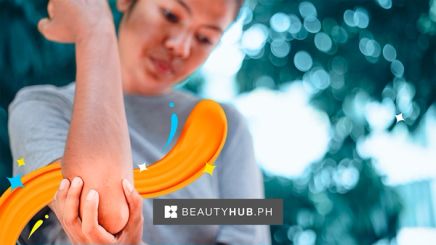
You probably have memories of your mom or lola nagging you to take your elbows off the table. Not just because it’s considered impolite, but also (and mainly) because doing so can turn the skin “black.” They’re not entirely wrong, though. Dark elbows develop for several reasons, including genetics and, yes, .
Hyperpigmentation around skin folds is common in all skin tones, yet to some, it signifies poor personal hygiene and self-maintenance. If darkened elbows are one of , keep scrolling to learn more about its causes and why it’s not at all shameful to have.
What Causes Hyperpigmentation on the Elbows?
Even if you follow every conceivable tip found on the internet, you can’t completely keep your elbows from darkening. Why? Because the skin in this region is thicker and has fewer sebaceous glands to provide moisture. This makes it and vulnerable to external aggressors.
Since the skin barrier on the elbows is weak, constant rubbing from clothes and day-to-day activities – like or reading a book while lying on your stomach – can set off inflammation. When the skin is damaged, it produces more melanin (skin pigments) in the affected area, leaving behind brown marks. Conditions like eczema and psoriasis can also trigger the same reaction.
One of the most obvious causes of dark elbows is . Prolonged sun exposure without sunscreen can lead to skin discoloration over time, as many people are aware. However, there are also invisible culprits, like hormonal fluctuations.
According to the , 90% of pregnant women experience “some form of hyperpigmentation.” The science behind this occurrence? Spikes in estrogen and progesterone levels can instigate a surge in melanin production.
So What If You Have Dark Elbows?
Everyone has dark elbows at some point in life, much like having belly fat. To see them as anything unnatural would make you hyper-aware of how your body should look and pick at problems that don’t actually exist. When will the self-hate train stop?
Even-toned elbows may not be the default for some people. Asians, in particular, have bigger since we carry more melanin-producing cells. But it’s not all bad. Having more melanin means you’re more protected against wrinkles and skin cancer. So, yay for darkened elbows!
Let Your Elbows Live
You might want to order that you saw on your feeds, but before you do, know the risks. Many skin-lightening products contain hydroquinone, which can have side effects like severe burning and swelling if used without the guidance of a dermatologist.
Human skin isn’t meant to come in only one shade. Some areas are darker, others are lighter. Instead of forcing your dark elbows to change overnight, you can treat it with the same kindness you show other parts of your body.
Moisturize, then moisturize some more.
Your elbows need your support in the hydration department. Help them by incorporating the “” technique into your routine.
Apply Vaseline Gluta Hya Serum Burst Lotion Flawless Bright after showering and before bedtime to replenish lost moisture in the skin. This body serum-slash-lotion has 10x Pro-Retinol that helps shed dead skin and even out your skin tone. Then, spread a thin layer of Vaseline Petroleum Jelly on your elbows to lock in all the moisture. No more ashiness!
Avoid scrubbing the skin too hard.
The dark patches on your elbows are not necessarily dirt. Scrubbing them off with or other harsh exfoliants only add more injuries to the skin, causing it to become thicker and darker. are the better options but use them in moderation. If you’re into extreme sports such as skateboarding or rock climbing, consider wearing elbow pads to prevent scraping.
Sun’s bright, shield right.
Make SPF your skin’s BFF, whether you’re lounging outdoors or working from home. Choose a broad-spectrum sunscreen infused with hydrating ingredients to help prevent skin dryness. More importantly, this helps protect your skin from sunburn and ramp up melanin production.
Having dark elbows is not the tragedy it appears to be. Chasing unrealistic beauty standards is fruitless, not to mention exhausting. The one thing we all need to change is how we perceive the imperfect parts of ourselves – which are perfect in their own ways. When you accept them as they are, no one can’t take their beauty away.